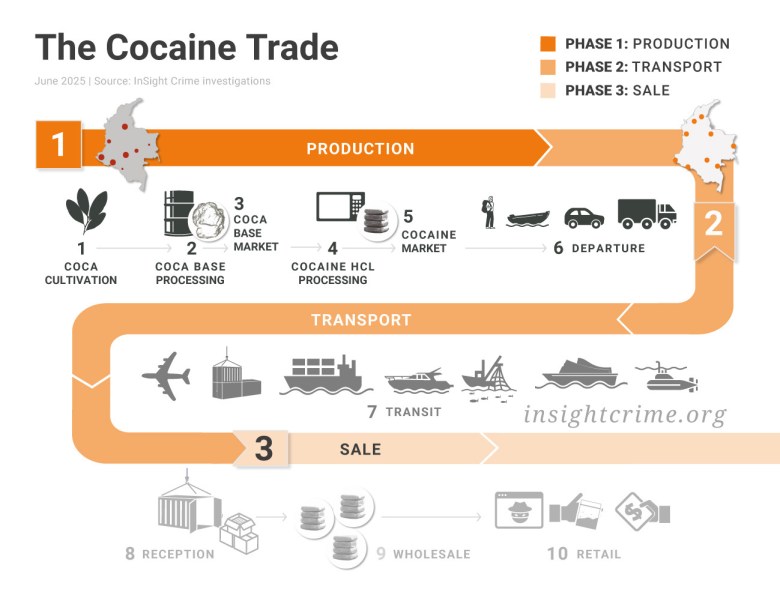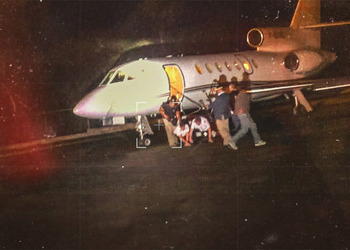A new Netflix docuseries centered on two pilots traveling aboard a cocaine-laden airplane has revived a drug trafficking case that ensnared France and the Dominican Republic and put a spotlight on just one part of the cocaine pipeline to Europe.
Alert: this article may contain spoilers.
On June 11, Netflix launched “Cocaine Air: Smugglers at 30,000 Ft.,” a new docuseries that tells the story of pilots Bruno Odos and Pascual Fauret, both of whom were in charge of flying a private plane that left the Dominican Republic for France in 2013. Before taking off, authorities arrested the two after discovering 700 kilograms of cocaine was stuffed into 20 suitcases on board. Police also captured the only passenger on board, Nicolas Pisapia, a supposed real estate agent the police linked to drug trafficking in France in previous investigations.
Odos and Fauret had flown some of the most important airplanes for France’s air force prior to moving into the private sector, which was geared more towards businesspeople or those interested in a more exclusive flying experience.
SEE ALSO: The Cocaine Pipeline to Europe
Since then, Odos and Fauret have denied they had any knowledge about the contents of the luggage on board, arguing that it wasn’t their responsibility to know. However, French authorities presented evidence that suggested the pilots had some knowledge about the cocaine on board this and other flights they flew from the Dominican Republic to key transit points in the cocaine pipeline to Europe, such as Ecuador.
The docuseries offers a window into the human side of drug trafficking. It follows several key moments in the judicial process against those implicates, including the voices of both them and the authorities leading the investigation.
InSight Crime Analysis
Cocaine trafficking from Latin America to Europe has been on the rise in recent years, even surpassing the US cocaine market, according to the US State Department’s latest International Narcotics Control Strategy Report (INCSR). This has come alongside a greater diversification of the actors throughout the trafficking chain and their modus operandi.
Beyond pilots, the cocaine supply chain today involves intermediaries and various interconnected criminal networks that sustain a multimillion-dollar cocaine market in Europe.
The cocaine pipeline to Europe begins in Colombia, Peru, and Bolivia, the world’s leading cocaine-producing countries. In the Cocaine Air case, the drugs likely originated in Colombia, the South American nation nearest to the coast of the Dominican Republic that has seen a substantial increase in cocaine production since 2013. Production there hit a new record in 2023, with 2,664 metric tons of cocaine.
Cocaine is also sent to Europe from transit countries, which sometimes raise less suspicion among European authorities. The Dominican Republic is a major transit point for cocaine arriving via speed and fishing boats from the northern coasts of Colombia and Venezuela. Once in the Caribbean country, the drugs depart in containers, narco-submarines, and executive flights – as was the case of Cocaine Air – among other means.

Although the new series focuses on the pilots, and even the executive airline, there are some key players in the drug trafficking chain who also deserve special attention: the intermediaries known as “brokers.” They connect different stages of the drug trafficking chain and foster trust among a wide variety of actors involved.
Douglas Farah, president of IBI Consultants, a consulting agency specializing in security in Latin America, told InSight Crime that there are three types of brokers. First, there are logistics brokers who perform local tasks for small networks. Second, there are facilitators who connect small markets with larger ones. Finally, there are hidden facilitators who provide services to various drug trafficking structures on a global scale.
A key broker in the Cocaine Air scheme was a French citizen named Franck Colin, who had a relationship with Nicolas Pisapia and was in charge of contacting the executive airline and paying for the flight. Colin, in turn, was connected to a French drug trafficker named Ali Bouchareb, who was later arrested for drug trafficking in Spain.
While Colin played a role in managing the logistics of the drug’s transportation from the Dominican Republic to France, it’s highly likely that the case involved other brokers. This includes those who connected the shipment from the producing countries to the Dominican Republic, the Caribbean networks that facilitated the entry of the drugs to the airport, and those who would unload the drugs in France. Although the docuseries doesn’t mention it, it’s likely that Bouchareb was also connected to larger European criminal networks with the capacity to transport cocaine to different markets throughout Europe.
Brokers have always played a key role in drug trafficking, but their importance has grown in recent years. While most brokers may have worked for just one criminal group in the past, today they can work for several different global networks.
“They offer a specialized service,” Farah said, “but the loyalty they once had is gone. They’re no longer wedded to the group they work for. They can work with whomever they want, with whoever is available, and it doesn’t mean a death sentence.”
While the Netflix production sheds light on the complex world of drug trafficking from Latin America to Europe, the Cocaine Air case is just one piece of a much larger puzzle that includes different transnational actors and increasingly fluid networks that have a significant capacity to adapt within an ever changing criminal world.
Featured image: Footage of the moment the pilots were captured by Dominican authorities in 2013. Credit: Hoy Newspaper
